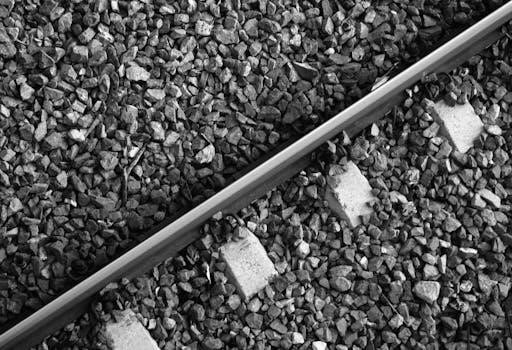Linear rails, also known as linear guides or guideways, are key components in systems requiring precise linear motion. They provide a smooth, accurate path for movement, supporting and guiding loads along a single axis.
Definition and Purpose of Rail Guides
Rail guides, referred to as linear guides, linear guide rails, or slides, are essential components in various mechanical systems designed to facilitate precise and controlled linear motion. Their primary purpose is to provide a smooth and accurate pathway along which a load can move with minimal friction and high stability. These guides consist of a rail and a bearing element, working together to support and direct movement along a single axis.
The main function of rail guides is to maintain alignment, reduce friction, and ensure repeatable positioning. This is crucial in applications where precision and consistency are paramount. By providing a dedicated track for motion, rail guides prevent unwanted deviations and vibrations, leading to improved efficiency, accuracy, and overall performance of the mechanical system.
Brief History of Rail Guide Development
The concept of linear motion guides can be traced back to ancient times, with primitive forms used in ancient Egypt. However, the modern iteration began to take shape during the industrial revolution. Initially, materials like wood, cast iron, and wrought iron were used.
Steel emerged as the dominant material due to its superior strength and durability. A significant milestone was the patenting of a modern linear guide in 1932. In 1972, Hiroshi Teramachi created the linear motion ball guide, Model LSR, by integrating a base with a ball spline shaft. This design enhanced stability and precision, paving the way for high-precision machining applications and widespread adoption in various industries.

Types of Rail Guides
Several types of linear guides exist, including linear bearing guides, profile rail guides, and roller guides. Each type offers unique characteristics suitable for different applications and performance requirements in various industries.
Linear Bearing Guides
Linear bearing guides utilize rolling elements between a carriage and a rail to facilitate smooth, low-friction linear motion. These guides are available with ball bearings, offering high speed and moderate load capacity, or with roller bearings, providing increased load capacity and rigidity. The world’s first linear motion ball guide (linear guide) was the Model LSR.
These guides are ideal for applications where precision is more important than load capacity, such as in computer numerical control (CNC) machines. Linear bearing guides effectively reduce friction and wear, protecting sensitive systems while maintaining exceptional performance under varying loads. Common types include flat roller guides, Gothic arch guides, and V-type guides.
Profile Rail Guides
Profile rail guides are a type of linear guide characterized by their profiled rail and matching bearing block. These guides offer high rigidity, load capacity, and accuracy, making them suitable for demanding industrial applications. Miniature profile rail guides for industrial applications are available.
The bearing block contains recirculating rolling elements, such as balls or rollers, that travel along the profiled raceways on the rail. Ball profile guide rail LLT and profile rail bearing are widely spread in many industries. Profile rail systems typically utilise materials such as stainless steel, hardened steel, or aluminium for their construction. They are nearly used for any linear guide application.
Roller Guides
Roller guides are a type of linear guide that utilizes rollers as the rolling elements between the rail and the carriage. There are several types of linear guides with roller bearings⁚ flat roller guides, Gothic arch guides, and V-type guides.
Compared to ball bearings, roller bearings offer a larger contact area, resulting in higher load capacities and increased rigidity. This makes roller guides well-suited for applications involving heavy loads and demanding precision. The roller guide rail SNS has a proven cover strip for covering mounting holes. You will find roller guide rails for fixed bearings or floating bearings in various materials and sizes. Also, Roller Guide Rail with temperature control.

Materials Used in Rail Guides
The selection of materials is essential for rail guides, influencing their longevity and performance. Common materials include steel, stainless steel, aluminum, and polymers, each offering unique properties for various applications.
Steel
Steel is a commonly used material in rail guides due to its strength and durability. It provides excellent load-bearing capabilities, making it suitable for heavy-duty applications. Steel rails can withstand high stresses and offer precise linear movement.
The high-quality steel used ensures longevity, even under demanding conditions. Steel rails often undergo anti-corrosion treatment to enhance their resistance to environmental factors. The hardness, strength, and toughness of steel make it ideal for high-speed moving equipment and precision machining.
However, minor flaws in the steel can pose issues in high-stress applications. Despite this, its cost-effectiveness and robustness make steel a popular choice. The material properties and manufacturing process of steel linear rails have reached a benign controlled range, making them standard products.
Stainless Steel
Stainless steel is a premium material choice for rail guides, offering superior corrosion resistance compared to standard steel. This makes it ideal for environments where exposure to moisture or chemicals is a concern. Stainless steel ensures longevity and reliability in harsh conditions.
The use of stainless steel in rail guides is prevalent in industries like food processing and pharmaceuticals. The cleanability and resistance to rust prevent contamination. Different grades of stainless steel are available. Each offer varying levels of corrosion resistance and strength.
While more expensive than steel, the enhanced durability of stainless steel often justifies the cost. The material‘s robustness ensures consistent performance and reduces the need for frequent replacements. The guide rails are often made of 304 stainless steel with a good finish. Stainless steel also benefits from resistance to high temperatures, broadening its range of applications.
Aluminum
Aluminum is a popular material for rail guides due to its lightweight nature and good corrosion resistance. This combination makes it well-suited for applications where weight is a critical factor. Aluminum rails are often found in automation systems and other equipment where minimizing inertia is essential.
While not as strong as steel, aluminum offers a favorable strength-to-weight ratio. This makes it an excellent choice for medium-duty applications. The material‘s natural oxide layer provides inherent corrosion protection, further enhancing its suitability for diverse environments. Aluminum rails are also easy to machine. This reduces manufacturing costs and allows for complex designs.
Aluminum rail guides are commonly anodized to improve surface hardness and wear resistance. This process enhances the material’s durability. It prolongs its service life in demanding applications. The choice of aluminum depends on specific performance requirements and cost considerations. Despite its lower strength, aluminum is often preferred because of its light weight.
Plastic and Polymers
Plastic and polymers are increasingly used in rail guides, offering unique advantages such as self-lubrication and vibration dampening. These materials are ideal for applications where noise reduction and smooth operation are crucial. Polymer-based rail guides often require minimal maintenance. This is due to their inherent ability to reduce friction without external lubrication.
Compared to metal rails, plastic and polymer options are lightweight and corrosion-resistant. This makes them suitable for environments where exposure to moisture or chemicals is a concern. Different types of polymers, such as nylon and UHMW, are selected based on specific application needs. Factors to consider include load capacity, wear resistance, and temperature stability.
Plastic rails are commonly used in light-duty applications. Examples include conveyor systems and packaging machinery. The use of polymers can also reduce the overall cost of the rail guide system. While not as strong as metal, plastic and polymer rails provide a cost-effective and reliable solution for many applications.

Applications of Rail Guides
Rail guides are essential in various applications, providing precise linear motion. They are used in industrial automation, CNC machines, conveyor systems, and railway turnouts. These guides ensure accuracy and stability in demanding environments.
Industrial Automation
In industrial automation, rail guides play a pivotal role in enhancing precision and efficiency. They are integral to robotic systems, ensuring smooth and accurate movements in pick-and-place operations. Linear guides facilitate the precise positioning of tools and materials, optimizing manufacturing processes.
The durability and reliability of rail guides contribute to the longevity of automated equipment. They withstand heavy loads and repetitive motion, reducing downtime and maintenance costs. High-precision linear rails are essential for tasks requiring exacting accuracy, such as semiconductor manufacturing and electronic assembly.
The use of rail guides enables the creation of highly automated production lines, increasing throughput and reducing labor costs. They support a wide range of automation applications, from simple linear motion to complex multi-axis systems. The selection of appropriate rail guides is crucial for achieving optimal performance and reliability in industrial automation settings. Their robust construction ensures consistent operation, even under demanding conditions, making them a vital component in modern manufacturing.
CNC Machines
CNC machines rely heavily on rail guides for precise and accurate movements. Linear rails enable the smooth and controlled motion of cutting tools and workpieces, ensuring high-quality machining. The rigidity and stability of rail guides are crucial for maintaining tight tolerances and achieving desired surface finishes.
High-precision linear guides minimize vibrations and deflection, enhancing the accuracy of CNC machines. They support heavy loads and withstand the forces generated during machining operations. The choice of rail guide material, such as steel or stainless steel, depends on the specific application and environmental conditions.
Rail guides contribute to the overall efficiency and productivity of CNC machines by enabling faster cutting speeds and reduced cycle times. They are essential for creating complex geometries and intricate designs. The use of linear rails ensures consistent and repeatable performance, minimizing errors and scrap rates.
Proper maintenance and lubrication of rail guides are critical for extending their lifespan and maintaining their accuracy in CNC machine applications. Their robust design allows for continuous operation, making them a vital component in modern manufacturing.
Conveyor Systems
Conveyor systems utilize guide rails to maintain product alignment and ensure smooth material flow. These rails guide items along the conveyor belt, preventing misalignment and jams. Conveyor guide rails are available in various materials, including stainless steel, plastic, and aluminum, to suit different applications and environments.
Adjustable guide rails accommodate various product sizes and shapes, providing flexibility in conveyor system design. They help optimize throughput and minimize product damage. Selecting the appropriate guide rail material is essential for resisting wear, corrosion, and impact.
In automated conveyor systems, guide rails play a crucial role in directing products to specific locations, such as sorting stations or packaging areas. They work in conjunction with sensors and control systems to ensure accurate and efficient material handling. The design of guide rails must consider factors such as product weight, speed, and environmental conditions.
Properly installed and maintained guide rails contribute to the overall reliability and performance of conveyor systems, reducing downtime and improving productivity. They are an integral component in a wide range of industries, including manufacturing, logistics, and food processing.

Railway Turnouts
Railway turnouts, essential for directing trains from one track to another, incorporate guide rails to ensure safe and smooth transitions. These guide rails, also known as check rails or guard rails, are strategically positioned to guide the wheels through the diverging or converging tracks. Different types of guide rails are utilized in railway turnouts, depending on specific application requirements.
Safety, availability, and durability are paramount considerations in guide rail design for railway turnouts. The materials used, typically high-quality steel, must withstand significant stress and wear. Proper maintenance of guide rails is crucial for preventing derailments and ensuring reliable operation.
The design and placement of guide rails in railway turnouts are critical for accommodating different wheel profiles and train speeds. These guide rails work in conjunction with the switch rails to guide the train wheels accurately. Advanced railway turnout systems often incorporate sensors and monitoring equipment to detect any issues with the guide rails or other components.
Ultimately, effective guide rails in railway turnouts contribute to the overall efficiency and safety of railway transportation networks.
